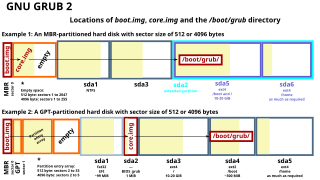 W
WIn computing, a file system or filesystem controls how data is stored and retrieved. Without a file system, data placed in a storage medium would be one large body of data with no way to tell where one piece of data stops and the next begins. By separating the data into pieces and giving each piece a name, the data is easily isolated and identified. Taking its name from the way paper-based data management system is named, each group of data is called a "file." The structure and logic rules used to manage the groups of data and their names is called a "file system."
 W
WAtari DOS is the disk operating system used with the Atari 8-bit family of computers. Operating system extensions loaded into memory were required in order for an Atari computer to manage files stored on a disk drive. These extensions to the operating system added the disk handler and other file management features.
 W
WA boot sector is the sector of a persistent data storage device which contains machine code to be loaded into random-access memory (RAM) and then executed by a computer system's built-in firmware.
 W
WCylinder-head-sector (CHS) is an early method for giving addresses to each physical block of data on a hard disk drive.
 W
WIn computer file systems, a cluster or allocation unit is a unit of disk space allocation for files and directories. To reduce the overhead of managing on-disk data structures, the filesystem does not allocate individual disk sectors by default, but contiguous groups of sectors, called clusters.
 W
WIn computing, a directory is a file system cataloging structure which contains references to other computer files, and possibly other directories. On many computers, directories are known as folders, or drawers, analogous to a workbench or the traditional office filing cabinet.
 W
WIn computing, a directory is a file system cataloging structure which contains references to other computer files, and possibly other directories. On many computers, directories are known as folders, or drawers, analogous to a workbench or the traditional office filing cabinet.
 W
WIn computer disk storage, a sector is a subdivision of a track on a magnetic disk or optical disc. Each sector stores a fixed amount of user-accessible data, traditionally 512 bytes for hard disk drives (HDDs) and 2048 bytes for CD-ROMs and DVD-ROMs. Newer HDDs use 4096-byte (4 KiB) sectors, which are known as the Advanced Format (AF).
 W
WIn computing, executable code, an executable file, or an executable program, sometimes simply referred to as an executable or binary, causes a computer "to perform indicated tasks according to encoded instructions", as opposed to a data file that must be interpreted (parsed) by a program to be meaningful.
 W
WThe system utility fsck is a tool for checking the consistency of a file system in Unix and Unix-like operating systems, such as Linux, macOS, and FreeBSD. A similar command, CHKDSK, exists in Microsoft Windows and MS-DOS.
 W
WMount Rainier (MRW) is a format for writable optical discs which provides the packet writing and defect management. Its goal is the replacement of the floppy disk. It is named after Mount Rainier, a volcano near Seattle, Washington, United States.
 W
WA virtual file system (VFS) or virtual filesystem switch is an abstract layer on top of a more concrete file system. The purpose of a VFS is to allow client applications to access different types of concrete file systems in a uniform way. A VFS can, for example, be used to access local and network storage devices transparently without the client application noticing the difference. It can be used to bridge the differences in Windows, classic Mac OS/macOS and Unix filesystems, so that applications can access files on local file systems of those types without having to know what type of file system they are accessing.